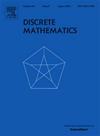团并的最小饱和图
IF 0.7
3区 数学
Q2 MATHEMATICS
引用次数: 0
摘要
设H是一个固定的图。如果图G不包含与H同构的子图,则图G称为H饱和图,但向G中添加任何缺失的边都会得到H在G中的副本。H的饱和数,记为sat(n,H),是所有n阶H饱和图中边的最小数量,而sat(n,H)表示具有sat(n,H)条边和n个顶点的H饱和图族。本文解决了Chen和Yuan(2024)[4]的一个猜想,即当q≥p≥2且t≥2时,确定了Sat(n,Kp∪(t−1)Kq)。本文章由计算机程序翻译,如有差异,请以英文原文为准。
Minimum saturated graphs for unions of cliques
Let H be a fixed graph. A graph G is called H-saturated if G does not contain a subgraph isomorphic to H, but the addition of any missing edge to G results in a copy of H in G. The saturation number of H, denoted , is the minimum number of edges among all H-saturated graphs of order n, and denotes the family of H-saturated graphs with edges and n vertices. In this paper, we resolve a conjecture of Chen and Yuan (2024) [4] by determining for every and .
求助全文
通过发布文献求助,成功后即可免费获取论文全文。
去求助
来源期刊

Discrete Mathematics
数学-数学
CiteScore
1.50
自引率
12.50%
发文量
424
审稿时长
6 months
期刊介绍:
Discrete Mathematics provides a common forum for significant research in many areas of discrete mathematics and combinatorics. Among the fields covered by Discrete Mathematics are graph and hypergraph theory, enumeration, coding theory, block designs, the combinatorics of partially ordered sets, extremal set theory, matroid theory, algebraic combinatorics, discrete geometry, matrices, and discrete probability theory.
Items in the journal include research articles (Contributions or Notes, depending on length) and survey/expository articles (Perspectives). Efforts are made to process the submission of Notes (short articles) quickly. The Perspectives section features expository articles accessible to a broad audience that cast new light or present unifying points of view on well-known or insufficiently-known topics.
 求助内容:
求助内容: 应助结果提醒方式:
应助结果提醒方式:


